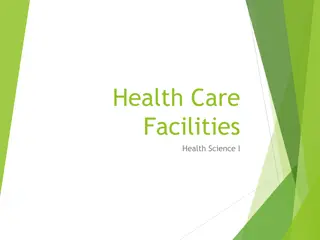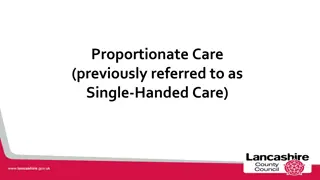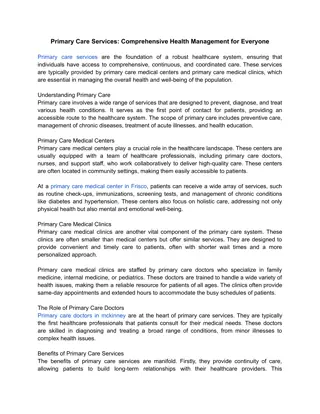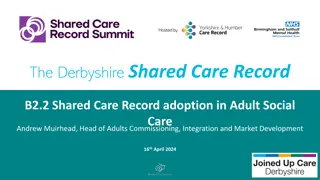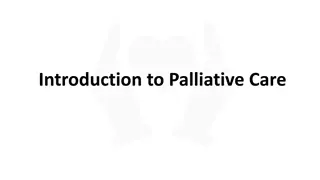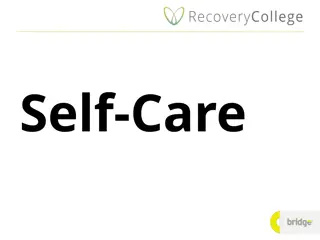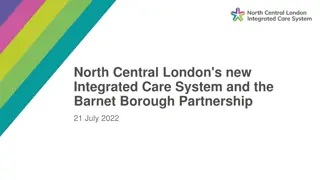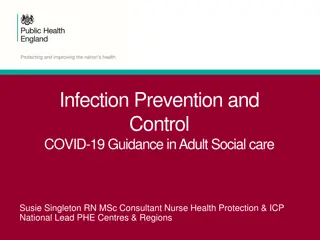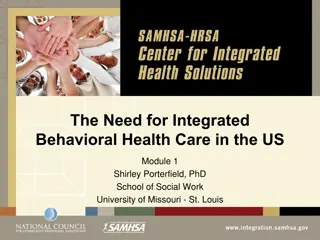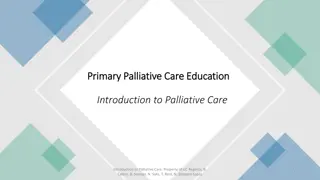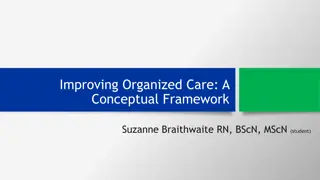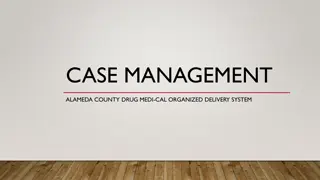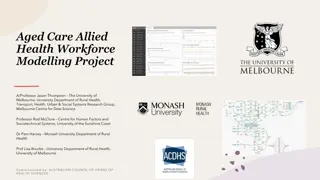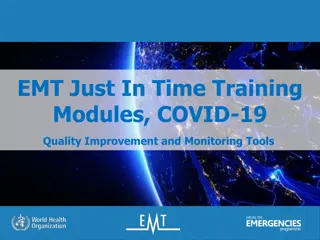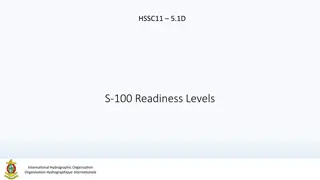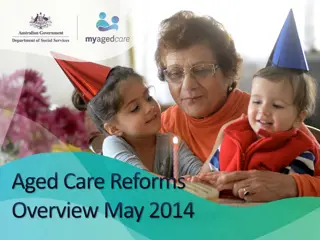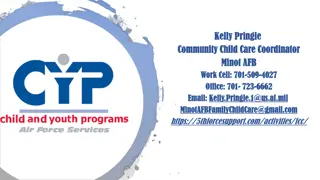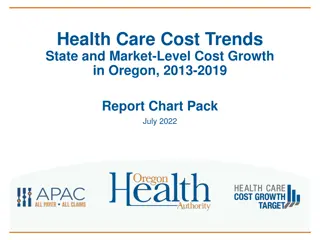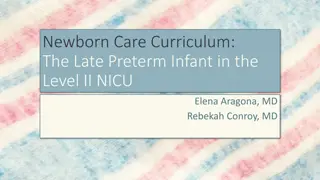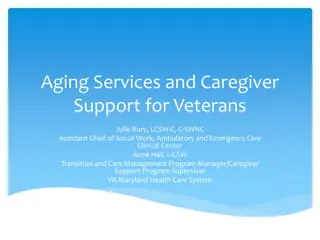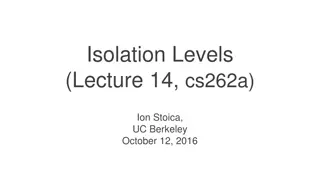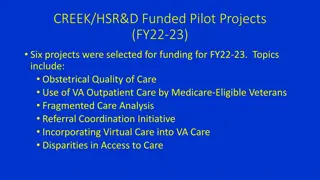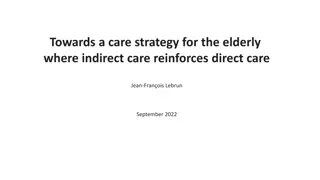Integrating Behavioral Health in Primary Care: Collaborative Care Model (CoCM) Approach
Explore the Collaborative Care Model (CoCM) and Behavioral Health Integration in Primary Care discussed at the North Carolina Community Health Care Association Clinical Conference. Learn about key objectives, roles, billing codes, and resources to promote overall health and reduce treatment gaps and
2 views • 35 slides
Understanding Special Monthly Compensation (SMC) Levels and Benefits
Special Monthly Compensation (SMC) offers various levels of benefits based on the extent of service-related disabilities, such as anatomical losses, blindness, and aid and attendance needs. Veterans may receive different SMC levels like SMC-K, L, M, N, and O depending on the severity and combination
1 views • 42 slides
Quick MD Care_ Your Trusted Partner in Primary Care Medicine
Quick MD Care: Your Trusted Partner in Primary Care Medicine\n\nWelcome to Quick MD Care, where compassionate primary care meets convenience. We understand the importance of having a trusted partner in managing your health. Our team of dedicated primary care doctors is committed to providing persona
5 views • 2 slides
Health Care Facilities
Explore a comprehensive guide to various health care facilities, including hospitals, long-term care facilities, medical offices, and clinics. Learn about the types of hospitals, such as general, specialty, government, and university hospitals. Discover the functions of long-term care facilities lik
0 views • 9 slides
Understanding Proportionate Care in Healthcare
Explore the concept of Proportionate Care, previously known as Single-Handed Care, which aims to increase capacity in the care market, reduce delayed transfers of care, and improve service user outcomes. Addressing common concerns and myths related to moving and handling tasks, this approach promote
0 views • 10 slides
Primary Care Services: Comprehensive Health Management for Everyone
Primary Care Services: Comprehensive Health Management for Everyone\n\nPrimary care services are the foundation of a robust healthcare system, ensuring that individuals have access to comprehensive, continuous, and coordinated care. These services are typically provided by primary care medical cente
2 views • 2 slides
Understanding The Differences Between Hourly Care and Live-In Care
Choosing the right type of Home Health Aide NJ for your loved one can be challenging. Whether you need occasional support or constant supervision, understanding the differences between hourly care and live-in care is crucial for making the best decision.\n\nFor more info visit: \/\/carebridge.care\/
1 views • 6 slides
The Derbyshire Shared Care Record: Integration in Adult Social Care
The Derbyshire Shared Care Record B2.2 adoption in Adult Social Care under the leadership of Andrew Muirhead is a significant initiative enhancing care quality and delivery. This project involves multiple agencies like Derby City Council, Derbyshire County Council, and healthcare trusts to integrate
0 views • 12 slides
Understanding Palliative Care: Enhancing Quality of Life in Serious Illness
Palliative care is a holistic approach focused on improving the quality of life for patients and their families dealing with life-threatening illnesses. It involves early identification, assessment, and treatment of pain and other physical, emotional, and spiritual issues. This comprehensive trainin
0 views • 60 slides
Child Care and Youth Programs at Minot AFB
Offering a range of child care services including Child Development Center for ages 6 weeks to 5 years, School Age Care for Kindergarten to 12 years, Family Child Care Program, and Youth Programs for ages 9-18. Services include full-time care, before/after school care, extended duty care, emergency
1 views • 6 slides
Developing a Self-Care Action Plan for Overall Well-Being
Self-care involves deliberate activities to nurture mental, emotional, physical, and spiritual health, yet it is often neglected. This guide explores the essence of self-care, emphasizes the importance of building a personalized self-care action plan, and provides insights into taking care of your b
0 views • 19 slides
Enhancing Palliative Care in Australian Residential Aged Care
PACOP, funded by the Australian Government Department of Health and Aged Care, is a program focused on improving palliative care in residential aged care facilities. It involves standardized assessment practices, early identification of care needs, and a collaborative model for sustainable support.
0 views • 10 slides
North Central London Integrated Care System Overview
The North Central London Integrated Care System (ICS) is a collaborative approach to healthcare planning and delivery across five boroughs. Led by the North Central London Health and Care Partnership, the ICS aims to meet the diverse health, public health, and social care needs of the region through
0 views • 29 slides
Hosting a Staff Briefing About T Levels
This slide deck, designed by the DfE T Levels Team, is a resource for schools/colleges conducting a staff briefing on T Levels. It aims to generate interest and positivity among staff about T Levels, providing a customizable presentation that can be delivered in 20-30 minutes. The deck includes note
1 views • 29 slides
Priorities and Quality Measures for Type 2 Diabetes Care in NHS GGC
Dr. Kashif Ali leads primary care for Type 2 diabetes, while Dr. James Boyle oversees secondary care in NHS GGC. The data from December 2018 shows the number of Type 2 diabetes patients, their care processes, HbA1c levels, and BMI status. The Diabetes Quality Improvement and Outcome Measures aim to
0 views • 27 slides
Adult Social Care Guidance on COVID-19 Prevention and Control
Infection prevention and control are crucial in adult social care, especially during the COVID-19 pandemic. This guidance, led by Susie Singleton RN MSc, provides resources and practical insights to help care providers and staff understand and implement effective measures. The resources cover topics
0 views • 12 slides
The Need for Integrated Behavioral Health Care in the US
Integrated Behavioral Health (IBH) care involves the coexistence of primary medical care and mental/substance use disorders treatment in the same setting. This model emphasizes collaboration between primary care and mental health practitioners, aiming for more effective treatment at lower costs. IBH
0 views • 43 slides
Child Care Challenges in Kentucky: The Child Care Cliff
Explore the landscape of child care in Kentucky, revealing the challenges families face with the Child Care Cliff. Discover statistics on child care centers, family child care homes, and the average cost of child care in Kentucky. Understand the importance of the Child Care Assistance Program (CCAP)
0 views • 18 slides
Comprehensive Primary Palliative Care Education Curriculum
This comprehensive primary palliative care education curriculum, designed by UC Regents, provides a nine-hour interactive program to equip clinicians with core knowledge, skills, and attitudes for caring for seriously ill patients and families. The curriculum covers topics such as psychological and
0 views • 20 slides
Practical Guide to Fabric Care: Caring for Clothes
This chapter focuses on fabric care and clothing maintenance, covering topics such as understanding care labeling, preparing clothes for laundering, using washing machines effectively, stain removal techniques, selecting detergents, utilizing dryers and irons correctly, and practical application of
0 views • 36 slides
Guidelines on EPA Region 9 Response Action Levels for TCE Contamination
EPA Region 9 has established response action levels for TCE contamination, with tiered concentrations for different exposure scenarios. The State of California provides guidance aligned with these levels. DTSC concurs with EPA's residential and industrial response levels but recommends consultation
0 views • 10 slides
Understanding Organized Care in Primary Care Settings
Organized Care refers to a natural community of caregivers with a shared commitment to proactive population and individual care management. Through effective and efficient practices, it serves the needs of patients across various settings and over time, with aligned goals and provider accountability
0 views • 18 slides
Comprehensive Overview of Alameda County Drug Medi-Cal Organized Delivery System Case Management
Comprehensive overview of the Alameda County Drug Medi-Cal Organized Delivery System's case management services, focusing on assisting beneficiaries in accessing necessary medical, educational, social, and community services. It includes details on care coordination, service coordination, goal orien
0 views • 17 slides
Addressing Allied Health Workforce Shortage in Australian Aged Care
Estimated shortfall of 25,000 Allied Health Care workforce by 2033 in Australian aged care system according to a commissioned report. Increasing training places and graduates by 3.5x from current levels is necessary to bridge the gap. The total number of eligible aged care service recipients is expe
0 views • 17 slides
Ensuring Safe and Effective Care in Emergency Medical Services during COVID-19
Understanding the importance of quality of care in EMTs during the COVID-19 response, implementing tools for improving care quality, and ensuring safe, timely, effective, and people-centered care delivery. The program highlights key considerations for managing EMT staff during pandemic operations, e
0 views • 25 slides
Pediatric Palliative Care and the Role of Interlink Nurses in Northern Ontario
Vicky Wilton, a Pediatric Interlink Nurse in Northern Ontario, presented on pediatric palliative care focusing on identifying differences and similarities between pediatric and adult care, integrating advance care planning, and emphasizing hope. The role of Pediatric Interlink Nurses within the Pedi
0 views • 69 slides
Understanding S-100 Readiness Levels for Product Development
The concept of S-100 Readiness Levels, based on NASA's Technical Readiness Levels, is crucial for progressing ideas from research to regular product use. This framework, introduced by the International Hydrographic Organization, ensures a clear understanding of a specification's readiness for operat
0 views • 9 slides
Overview of Aged Care Reforms in May 2014
Aged Care Reforms in May 2014 introduced significant changes to the aged care sector in Australia. The reforms aimed at providing quality care for older Australians, reducing red tape, and enhancing services such as Home Care Packages, MyAgedCare, and the Australian Aged Care Quality Agency. Changes
0 views • 45 slides
Minot Air Force Base Family Child Care Programs
Offering a variety of child care services including Child Development Center (CDC) for infants to 5 years old, School Age Care (SAC) for Kindergarten to 12 years, Youth Programs for ages 9-18, and Family Child Care Program (FCC) for infants to 12 years. Additional programs include Extended Duty Care
0 views • 6 slides
Enhancing Dementia Care through Goal-Directed Approaches
This content delves into the importance of goal-directed care in improving the quality of life for individuals with dementia. It covers shifting the focus of care from disease-based to person-centered approaches, outlining the goals of dementia care at different stages, and emphasizing the value of
0 views • 19 slides
Scotland's Independent Care Review: Creating Change for Care-Experienced Children
The Independent Care Review in Scotland engaged with care-experienced children and families to address the shortcomings of the care system. Through listening and understanding their experiences, detailed reports were produced outlining a vision for a more compassionate and effective care system. Pla
0 views • 17 slides
Impacts of Marketisation on Home Care for Older People in Urban China
This study by Wenjing Zhang from the University of Bristol delves into the effects of the marketisation process on home care for the elderly in urban China. It explores the rationale behind the marketisation of care, the trends in home care marketisation, and the processes involved. The background s
0 views • 19 slides
Health Care Cost Trends in Oregon: 2013-2019 Report Insights
The report delves into the cost growth trends in health care in Oregon from 2013 to 2019, highlighting the establishment of the Sustainable Health Care Cost Growth Target Program by the state legislature. It monitors and reports on factors driving health care cost increases, with a focus on per-pers
0 views • 35 slides
Newborn Care Curriculum for Late Preterm Infants in Level II NICU
This curriculum module focuses on the care of late preterm infants in Level II NICU settings, covering topics such as respiratory management, feeding difficulties, hypoglycemia, hypothermia, sepsis, hyperbilirubinemia, and discharge planning. It includes learning objectives, nursery care levels, phy
1 views • 42 slides
Investing in Extra Care in Manchester: A Cost Benefit Analysis
Devolution and new investment in Health & Social Care in Manchester led to the use of Cost Benefit Analysis (CBA) to secure funding for Extra Care services. By presenting business cases supported by CBA, Manchester secured funding for innovative care models, including Extra Care, improving access to
0 views • 12 slides
Comprehensive Aging Services and Caregiver Support for Veterans
Veterans can access a variety of aging services and caregiver support resources through the VA Maryland Health Care System. Eligibility is determined based on service connection and financial thresholds. Services include homemaker/home health aide, adult day health care, respite care, continued home
0 views • 23 slides
Understanding Isolation Levels in Database Management Systems
Isolation levels in database management systems provide a way to balance performance and correctness by offering various levels of data isolation. These levels determine the degree to which transactions can interact with each other, addressing conflicts such as dirty reads, non-repeatable reads, and
0 views • 18 slides
VA Healthcare Pilot Projects FY22-23
Six VA-funded pilot projects for FY22-23 focus on improving obstetrical quality of care, outpatient care utilization by Medicare-eligible veterans, fragmented care analysis, referral coordination, virtual care integration, and addressing disparities in access to care. Projects include assessing obst
0 views • 7 slides
Enhancing Elderly Care: Direct and Indirect Support Strategies
Implementing a care strategy for the elderly involves integrating both direct, personal care activities and indirect care tasks. This approach benefits two key target audiences, including millions with varying levels of dependency and informal carers. The positive impacts of indirect care include we
0 views • 7 slides
Understanding Subacute Care: Types of Residents and Care Settings
Subacute care involves providing specialized care for individuals who require more attention than what typical long-term care facilities can offer. This level of care is provided in settings like hospitals or certain units within long-term care facilities. Residents in subacute care settings need a
0 views • 62 slides



